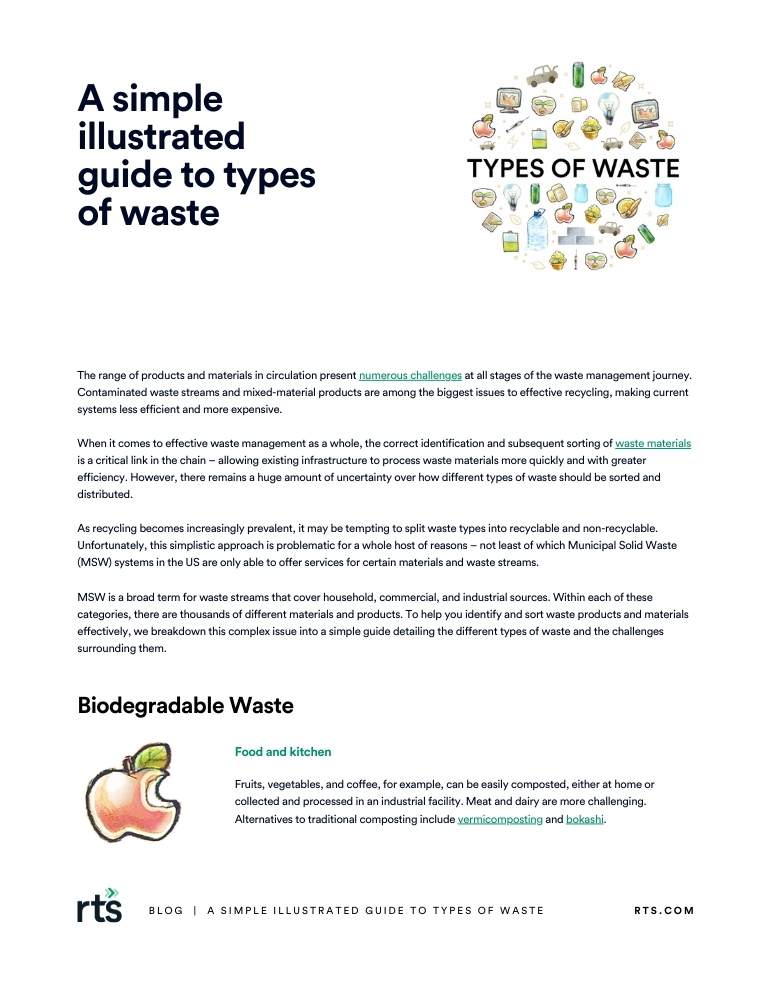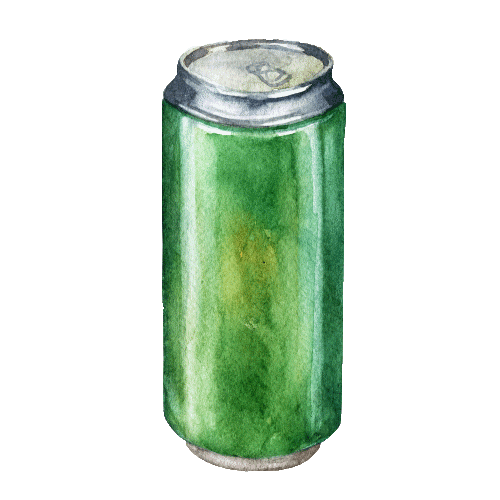The range of products and materials in circulation present numerous challenges at all stages of the waste management journey. Contaminated waste streams and mixed-material products are among the biggest issues to effective recycling, making current systems less efficient and more expensive.
When it comes to effective waste management as a whole, the correct identification and subsequent sorting of waste materials is a critical link in the chain – allowing existing infrastructure to process waste materials more quickly and with greater efficiency. However, there remains a huge amount of uncertainty over how different types of waste should be sorted and distributed.
As recycling becomes increasingly prevalent, it may be tempting to split waste types into recyclable and non-recyclable. Unfortunately, this simplistic approach is problematic for a whole host of reasons – not least of which Municipal Solid Waste (MSW) systems in the US are only able to offer services for certain materials and waste streams.
MSW is a broad term for waste streams that cover household, commercial, and industrial sources. Within each of these categories, there are thousands of different materials and products. To help you identify and sort waste products and materials effectively, we breakdown this complex issue into a simple guide detailing the different types of waste and the challenges surrounding them.
Biodegradable Waste
Food and kitchen
Fruits, vegetables, and coffee, for example, can be easily composted, either at home or collected and processed in an industrial facility. Meat and dairy are more challenging. Alternatives to traditional composting include vermicomposting and bokashi.
Garden
Almost all types of garden waste can be composted without issue. Large amounts of garden waste may need to be taken to a special facility for processing.
Paper and card stock
Most types of paper and card stock can be composted, although they provide little benefit to nutrient levels in soil. Often, recycling is a better approach and most cities provide recycling services for paper and card stock.
Current Challenges
Food waste in particular is a huge issue in the US. Where local composting facilities do not exist, food waste often ends up in landfills where it releases methane and co2 into the air, contaminates groundwater, and is a magnet for rodents and other pests.
Possible Solutions
For any business working with food, striving for zero food waste along the entire production and consumption chain must be a priority. Today, many cities are introducing programs designed to minimize food waste, for example, New York’s policies on commercial organics have been created to better eliminate food waste.
Recyclable Waste
Plastic
Plastic packaging and products that are made from a single material can be easily recycled. Materials include PET, HDPE, and PP. Plastics that are sometimes or almost never recyclable include PVC, LDPE, and PS. Most cities will provide recycling services for some or all plastics.
Aluminum and other metals
Aluminum and other recyclable metals are easily processed. Most metals are infinitely recyclable, meaning the quality of material does not degrade during the recycling process. Cities usually offer comprehensive metal recycling programs.
Paper and card stock
Paper and card stock are among the most easily recyclable items. However, if treated or combined with other materials (such as plastic), they can pose a problem for existing recycling systems.
Glass
Glass is infinitely recyclable, but, single-use glass packaging can be expensive and resource-intensive. Deposit programs for returning glass bottles may offer a viable and more sustainable alternative. Cities may offer one of these options or both.
Current Challenges
While glass and aluminum are considered infinitely recyclable, in reality they rarely are. Contaminated waste streams mean that quality degrades over time. Additionally, plastic can only be recycled a limited number of times, and its ubiquity today means that existing facilities cannot meet demand.
Possible Solutions
Reduction and reuse should be prioritized wherever possible. When recycling is required, ensuring waste streams are uncontaminated so existing facilities can more easily process materials is critical. The City of Boston is hoping to reduce landfill by up to 40% through its comprehensive recycling programs that allow easy identification of waste streams.
Universal and Electronic Waste (E-waste)
Batteries
Most types of batteries can be recycled, however, some are more easily processed than others. Lead-acid automotive batteries are the most commonly recycled, while disposable alkaline batteries are the least. Batteries must be disposed of in line with guidance from your municipality.
Electric and electronic devices
The complexities of electric and electronic devices make recycling a huge challenge. Additionally, the toxic elements contained in such devices can be extremely hazardous. Repair and reuse are better alternatives to recycling. Cities typically offer drop-off points for electronics where they are sometimes recycled or repaired.
Lightbulbs
Lightbulbs are currently not recyclable. Like batteries, toxic chemicals and materials contained within the various types of lightbulbs are hazardous. Lightbulbs must be disposed of in accordance with city guidelines.
Current Challenges
E-waste is among the fastest growing waste stream on the planet. The numerous challenges facing the correct disposal and recycling of these products and the materials contained are still being addressed. Recycling may use toxic chemicals or complex machinery but is infinitely better than landfills.
Possible Solutions
Reduction and reuse of e-waste should be a goal. As technology moves forward, cities should be able to better deal with these complex waste streams as facilities become more advanced. Additionally, companies should partner with specialized universal waste recyclers to have those materials recycled since they can’t be thrown in traditional recycling bins at home/work with traditional recyclables.
Inert Waste
Construction and demolition
Much of the waste generated during construction and demolition is considered inert waste. The huge range of materials within this waste stream, including hazardous materials, make this definition problematic. In most cases, construction and demolition waste is disposed of in special facilities.
Rubble, soil, and debris
Other garden waste such as rubble, soil, and non-green debris can typically be repurposed in construction works or throughout the garden. Conventional landfill remains an option for this type of waste.
Current Challenges
The challenges facing the correct disposal and potential recycling of construction and demolition waste are multiple. Very often, this type of waste is mixed, with only certain materials separated for recycling. Additionally, composite materials may be difficult to recycle, while hazardous substances must be disposed of in specialized facilities.
Possible Solutions
While inert waste is among the least problematic from an environmental perspective, it is also among the most ubiquitous. Today, steps are being made to push the construction industry towards zero waste. For example, at one of the highest density event spaces in the country RTS was able to deliver and empty 16 open top containers at a construction and demo facility that reported a 91% diversion rate due to the infrastructure they have set up to sort mixed materials appropriately.
Composite Waste
Clothing and shoes
The composite nature of clothing and the multiple materials used within manufacturing mean that recycling can be problematic. Donation is often a viable outlet for clothing and shoes that are in good condition, and a few municipalities may offer specialist recycling services for these waste types.
Other types of composite waste
Composite materials are among the most challenging products to process and recycle due to the multiple materials used—often requiring highly-technical machine, chemical, or hand separation.
Current Challenges
Composite materials are among the most challenging products to process and recycle due to the multiple materials used—often requiring highly-technical machine, chemical, or hand separation.
Possible Solutions
Clothing and other fabrics can easily be donated or reused as rags. There are also niche recycling companies that specialize in hard to recycle materials like G2 Revolution, TerraCycle, and Helpsy. At RTS, we help our clients connect some of those composite waste materials to creative outlets for use in art projects and donations for example.
Hazardous Waste
Paint and other chemicals
Paint and other liquid chemicals are usually highly toxic and must be disposed of correctly. Consult your local municipality for details on the correct facilities for disposal.
Tires
In many cases, tires can be recycled, with the resulting material often used in construction. However, tires are also burned or simply dumped, and a host of highly toxic chemicals are produced in these cases.
Other types of hazardous waste
There are many other types of hazardous waste, and many products that contain hazardous materials. Anything labeled as such should be carefully disposed of after consulting your city’s guidelines.
Current Challenges
Hazardous waste requires specialist chemical processing, otherwise it is incinerated. If processed, its final destination is usually a landfill. Finding innovative ways to more effectively deal with this type of waste is critical for sustainable hazardous waste management.
Possible Solutions
Finding innovative ways to more effectively deal with this type of waste is imperative for sustainable hazardous waste management. However, in most cases changing the types of chemicals we use in these materials is the only way to combat the challenges they present. More information on alternatives for a wide range of chemicals can be found here.
Special Hazardous Waste
Medical waste
Medical and biomedical waste is both hazardous and potentially infectious. Proper management of this waste is critical to both human and environmental health. Specialist disposal facilities exist for this type of waste, very often involving incineration.
Other types of special hazardous waste
Other types of special hazardous waste, including explosive and nuclear waste, are usually generated in an industrial setting. This kind of waste must be disposed of carefully and in accordance with national and international law.
Current Challenges
These very specialist types of waste must be collected safely, delivered to the correct facilities, and processed using specialized methods. When handling these products, safety precautions must be adhered to and professional guidance sought.
Possible Solutions
Incineration remains the only surefire way to deal with infected medical waste. However, it is hoped that as healthcare industry advances more sustainable alternatives can be found.
Download this blog to share.
We’ll e-mail you a printable version.

For more information on how your business can better identify and sort waste streams, implement effective waste management practices, and increase recycling and composting, read the RTS Guide to Waste Management or contact a member of our team today.














